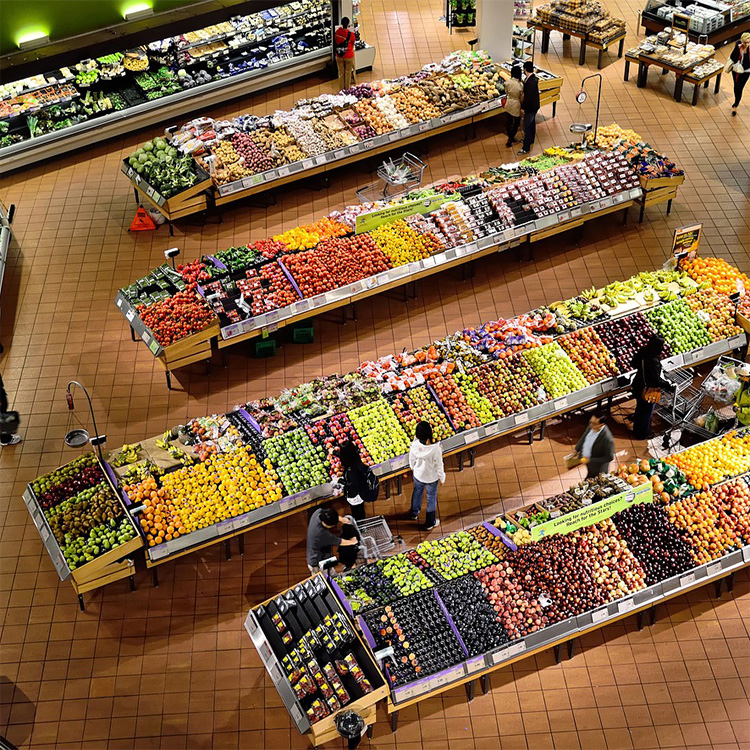Ever wonder what you should put on your shopping list for muscle gains?
You decide you want to start a bulking phase, gain some weight, and build muscle strength and size. Your training program includes some high-volume work in the gym (3 to 5 sets, 6 to 12 reps per exercise) to promote muscle growth.
But what should you be eating for muscle gains?
That’s a great question. Let’s start with what not to buy:
What not to buy for muscle gains
There’s a reason an estimated one-third of the world’s population is overweight or obese.[1]
The next time you take a trip to the grocery store, take a look at what other people are buying.
You’ll likely see shopping carts loaded with frozen pizza, microwave dinners, sugary cereals and drinks, processed deli meats, chips, crackers, cookies, canned soups, and lots of other junk food.
But these foods are high in calories? Don’t you want to eat more calories than you need for muscle gains?
Yes. But this kind of diet loaded with empty calories and foods high in refined carbohydrates and trans fats (bad fats linked to a long list of health problems and chronic disease) is a recipe for obesity.
In Australia, an estimated 63 percent of all adults are overweight or obese.[2] And it isn’t any better in the United States where about 70 percent of adults are overweight or obese.[3] In fact, in a recent survey, researchers found that the average adult eats the following per year:[4]
- 29 pounds of French fries
- 23 pounds of pizza
- 2.7 pounds of salt
- 24 pounds of ice cream
- 53 gallons of soda
- 11 pounds of chocolate
- 23 pounds of cheese
If eating more calories than you need was the only thing that mattered for muscle gains, everybody would be in great shape. But that’s just not the case.
What you eat matters for muscle gains. And it’s just as important to make the right food choices to build muscle as it is to lose weight.
Nutrition guidelines for muscle gains
If you were trying to lose weight or get lean, most health experts agree that dropping 1-2 pounds a week is a safe and realistic goal.
It’s possible to gain weight at that rate too, but without the right eating plan, weight gain from a calorie surplus will likely be unwanted fat and not muscle.
Gaining muscle takes a little longer. Here’s what you need to do:
-
Eat more calories than you need. About 500 to 600 calories above maintenance.
-
Focus on eating at least 1 gram of protein per pound of body weight.
-
The rest of your calories should come from healthy fats, then carbohydrates.
- Follow a hypertrophy training program to promote muscle growth
With an emphasis on protein, a calorie surplus and smart training program, it’s possible to gain about a 0.3 to 0.5 pounds of muscle a week over a three-month period.[5]
You’ll also gain some fat, too. That’s fine. When you reach the end of your bulk, it’s time to shred.
Grocery Shopping for Gains
During my last bulk, I ate pretty much the same foods while I was training to gain muscle strength and size.
I typically eat 300 grams of protein a day. In a calorie surplus, that still leaves me plenty of room for other foods, including a few items you might not expect.
When I’m bulking, I enjoy some foods I normally wouldn’t during a cutting phase. But that doesn’t mean eating a massive calorie surplus.
Here’s a snapshot of what I eat and recommend during a bulking phase. Your grocery-shopping-for-gains list should include
-
Fruit.
Bananas, blueberries., etc. Add bananas or berries to oats, Greek yogurt, or whole-grain cereal. -
Vegetables.
Broccoli, Brussel sprouts, sweet potatoes. Lots of options that are low in calories and high in fibre and other nutrients. -
Meat.
Lean beef, steak, chicken, and one of my personal favorites Kangaroo sausages. These are all great lean protein sources. -
Fish.
Canned tuna in oil. Or try filets baked or grilled. -
Cereal.
Whole-grain oats or cereal. I’ve been eating quick oats as a pre-workout meal for years. 60 grams is typical, but for bulking I go up to 80 grams. -
Pasta. You’ll have to look for this, but some stores sell high-protein pasta. The brand I like has 25 grams of protein per serving. Top it off with pasta sauce.
-
Greek yogurt.
Great protein source low in fat. - Treats.
Pop-Tarts, Nutella, low-fat ice cream. Yes, you can enjoy these treats. As long as you don’t go over your daily calorie goal and meet your macros, you’ll still get the same results. Just don’t go overboard.
Eating during a bulking phase gives you a chance to loosen the reigns on your diet a little. You’ll have room to enjoy a few treats. But you’ll still be eating healthy. And to pack in enough calories, to get the most out of a bulking phase, you’ll need to train hard, eat throughout the day and keep cardio to a minimum.
Need help figuring how to eat to build muscle, get lean, or lose weight? Get a customized nutrition and training program to help you hit your goal in 8 to 12 weeks.
References
- Murray, J.L, et al. (2017). Nearly one-third of the world’s population is obese or overweight, new data show. Institute for Health Metrics and Evaluation. From: http://www.healthdata.org/news-release/nearly-one-third-world%E2%80%99s-population-obese-or-overweight-new-data-show.
- Australian Institute of Health and Welfare. (2017). Overweight and obesity. From: http://www.aihw.gov.au/overweight-and-obesity/.
- Centers for Disease Control and Prevention. (2017). Overweight & obesity. From: https://www.cdc.gov/obesity/.
- Centers for Disease Control and Prevention. (2012). National Health and Nutrition Examination Survey. From: https://www.cdc.gov/nchs/nhanes/index.htm.
- Schuler, L. (2015). What’s the most muscle you can gain? Men’s Health. From: http://www.menshealth.com/fitness/how-much-muscle-can-you-gain.

